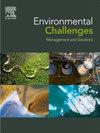苏丹努比亚含水层地下水污染物对人类健康风险的综合评估:结合来源分配和概率分析
Q2 Environmental Science
引用次数: 0
摘要
地下水污染是一个重大的全球挑战,特别是在干旱和半干旱地区,地下水是饮用和灌溉的主要来源。这种污染与人类健康风险密切相关,可能导致严重疾病和长期健康后果。在这项研究中,对苏丹申迪地区努比亚含水层系统(NAS)的地下水质量进行了评估,以评估与氮化合物(NO₂,NO₃,NH₃)和氟化物(F)相关的健康风险。该分析集成了自组织图(SOM)、主成分分析(PCA)和基于蒙特卡罗的健康风险模拟。SOM分析揭示了地下水样品中明显的聚类模式,确定了三个主要的水化学趋势。主成分分析表明,NO₃浓度升高是局部的,主要与农业径流有关,而NO₂和NH₃反映了农业和废水的污染。高氟化物浓度与地质来源有关,特别是与含氟矿物的水岩相互作用。蒙特卡罗模拟评估了概率健康风险,揭示了与成人相比,儿童的平均危险商数(HQs)和危险指数(HI)值更高。儿童的平均HI为1.06,明显超过安全阈值,表明潜在的非致癌性健康危害。Sobol敏感性分析确定了形成健康风险的最具影响力的参数,包括平均暴露时间、体重和暴露持续时间,强参数相互作用放大了这些影响。在污染物中,NO₃和F对累积HI值的贡献最大。这些发现强调迫切需要有针对性的干预措施,如先进的水处理、更严格的污染控制和公共卫生意识项目,以减轻地下水污染和保护弱势群体。本文章由计算机程序翻译,如有差异,请以英文原文为准。
Integrated assessment of human health risks from groundwater pollutants in Nubian Aquifer, Sudan: Combining source apportionment and probabilistic analysis
Groundwater contamination is a significant global challenge, particularly in arid and semi-arid regions where groundwater is a primary source for drinking and irrigation. This contamination is closely associated with human health risks, potentially leading to severe diseases and long-term health consequences. In this study, the groundwater quality of the Nubian Aquifer System (NAS) in the Shendi area, Sudan, is assessed to evaluate health risks linked to nitrogen compounds (NO₂, NO₃, NH₃) and fluoride (F). The analysis integrates self-organizing maps (SOM), principal component analysis (PCA), and Monte Carlo-based health risk simulations. SOM analysis revealed distinct clustering patterns in groundwater samples, identifying three major hydrochemical trends. PCA indicated that elevated NO₃ concentrations were localized, primarily associated with agricultural runoff, while NO₂ and NH₃ reflected pollution from both agriculture and wastewater. High fluoride concentrations were linked to geogenic sources, particularly water-rock interactions with fluorine-bearing minerals. The Monte Carlo simulation assessed probabilistic health risks, revealing higher mean hazard quotients (HQs) and hazard index (HI) values for children compared to adults. Children’s mean HI of 1.06 significantly exceeds the safe threshold, indicating potential non-carcinogenic health hazards. Sobol sensitivity analysis identified the most influential parameters in shaping health risks, including average exposure time, body weight, and exposure duration, with strong parameter interactions amplifying these effects. Among contaminants, NO₃ and F contributed the most to cumulative HI values. These findings underscore the urgent need for targeted interventions, such as advanced water treatment, stricter pollution controls, and public health awareness programs to mitigate groundwater contamination and protect vulnerable populations.
求助全文
通过发布文献求助,成功后即可免费获取论文全文。
去求助
来源期刊

Environmental Challenges
Environmental Science-Environmental Engineering
CiteScore
8.00
自引率
0.00%
发文量
249
审稿时长
8 weeks
 求助内容:
求助内容: 应助结果提醒方式:
应助结果提醒方式:


